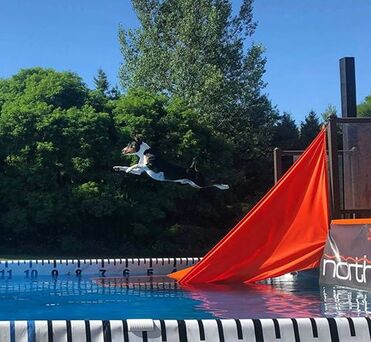|
If you have a working dog chances are they're always on the move! Whether they're running around on an agility field or strutting their stuff in the conformation ring our dog's ability to move well will dictate much of their success in the show ring. Like us, our dogs can move in multiple planes of motion and the sports we do may ask them to move in one or more planes. In my last blog I talked about the importance of structure and understanding how it can affect your dog's performance. This week I'd like to take you through our dog's planes of motion. What are Plane of Motions?When we talk about planes of motion what do we mean? Quite simply it is a way for us to break down the body into anatomical planes or flat surfaces. Our dog's bodies are broken down into three different anatomical planes. Imagine theses three planes as imaginary lines that pass through the body and represent the dynamic planes of motion that the body is capable of moving through. There are three planes of motion our dogs move in:
Conditioning work and planes of motion Our conditioning workouts often have exercises that work in different planes of motion. For example, the sit to stand, down to stand, and the cavaletti exercises all require movement in the median plane. Exercises that require weight shifting, turning in circles, or wrapping around a cone all work within the dorsal plane of motion. Finally, in the transverse plane of motion you'll see workouts like roll over, lateral stepping, and perch work with the front feet elevated. As we work through our conditioning exercises it's important to recognize that certain exercise will work with only one plane of motion while other, more difficult workouts, will work multiple planes. For example, think on one of the weight shifting progression we ask our dogs to do. We ask our dog to stand on two K9 bones while we walk around them. In this exercise we have our dog standing and weight shifting; when our dog is looking straight forward they're in the median plane but as the handler begins to move around the dog we begin to engage in the dorsal plane of motion. Remember that increasing the planes of motion your dog is working in is also a great way to increase the challenge of exercises. Different sports place different demands! Kevlar owned by Michelle McDonald Kevlar owned by Michelle McDonald Like our conditioning exercises the sports we do can also work one or more planes of motion. This may seem self-evident but think of the sport you participate in with you dog. Can you determine how many planes of motion are engaged? You may be surprised! Let’s take dock diving as an example – in this sport our dogs run down a dock before leaping into a pool to retrieve a toy. The length of the dog’s jump is then measured to determine their placement. Consider for a moment, the physical mechanics needed to make this jump and the plane of motions that needed to be engaged? If you guessed that the median or sagittal plane is primarily used you'd be correct! When dock diving there is very little movement of the dorsal or transverse plane. Instead the median / sagittal plane is engaged to propel the dog forward to the end of a dock. Other sports will also have different demands. The sport of agility, for example, with its bending, jumping, and twisting will require movement from all three planes. Meanwhile, a sport like obedience will primarily have movement from the median and dorsal plane. Each sport you participate in will place different demands on your dog's body and knowing what those demands are and what you can do to help your dog meet challenges will not only reduce their risk of injury but also increase longevity in their sport! Why is knowing the plane of motion important?Having a clear understanding of planes of motion and how they relate to your sport is important for a couple of reasons. I am a huge advocate for the importance of warm-up and cool downs during and after physical activity. A proper warm-up should mimic the movements your dog will do in their sport which means you'll need to know what planes of motion your dog's sport uses. Fast paced dog sports like flyball and agility often ask our dogs to work in all three planes so ensuring your mimicking movement in all three planes will ensure your dog is properly warmed up. A proper warm-up prior to physical exertion is crucial in preventing injury!
The second reason is that we can better guide our conditioning program. Over the years I've found that sometimes conditioning students and clients can become entrenched in a specific exercise set up. We want variety in our exercise programs and we want a program that is balanced with workouts engaging all three planes of motion! By working in all three planes of motion we avoid muscle imbalance. After all, it's rare our dogs will be working in only one plane of motion so our exercise program should also reflect this! By working in all three planes of motion we increase our dog's range of motion, better stabilize their bodies, and reduce their risk of injury. The better our dogs understand how their body moves then the better their chances are of executing movement correctly and avoid long term issues that can be caused by poor form. Simply put, working in all three planes of motion helps your dog prepare their body for life! If you'd like some advice on how to better incorporate planes of motion in your conditioning routine shoot me a message.
0 Comments
Leave a Reply. |
AuthorCarolyn McIntyre Archives
June 2024
Categories
All
|


 RSS Feed
RSS Feed